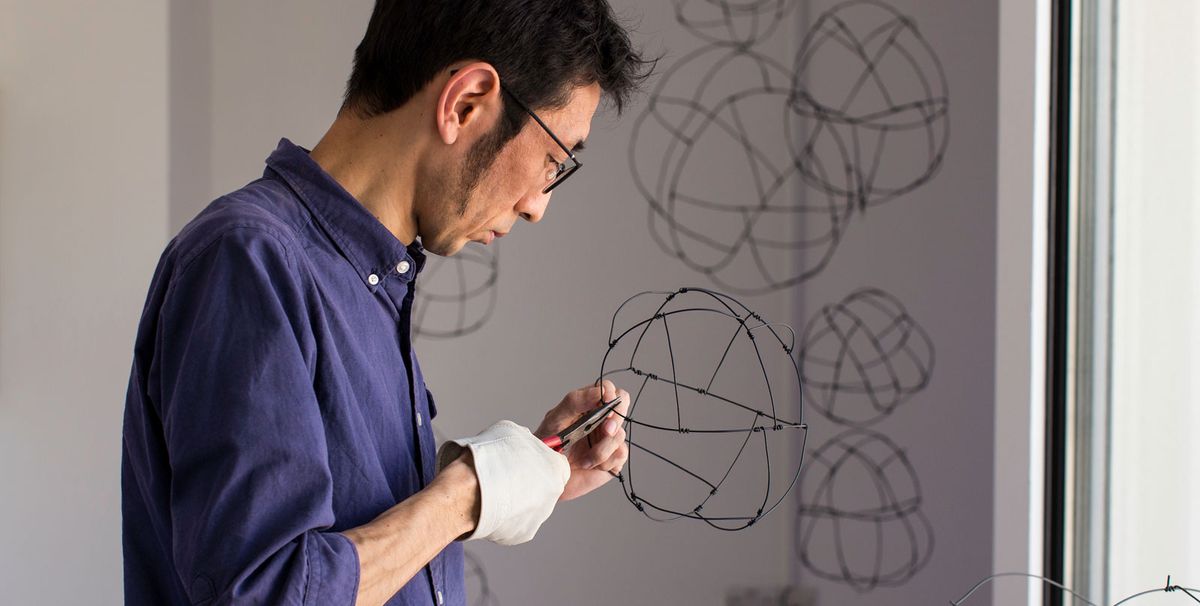The typical United Arab Emirates (UAE) resident is not a local. Often described as the world’s largest cultural melting pot (the UAE is never one to pass on the use of a superlative), the country is home to more than 200 nationalities, with Emiratis constituting less than 20% of the population. This fact permeates every aspect of life in the small Gulf nation, including the arts. The cultural output from the UAE is as broad as its wide variety of citizens.
For the 2018 edition of Art Dubai (21-24 March), a new artist residency programme aims to distil and package this act of blending in to belong, which is part of daily life in the UAE, and present it to a group of international artists as an experience. Prior to the fair, 11 artists lived and worked in three locations in Dubai and Abu Dhabi for one month to discover and digest the feeling of being a visitor in a place surrounded by transience. New work made during these residencies, which merges their artistic practice with their surroundings, will be shown at the fair by the artists’ respective galleries in a new section called Residents.
Not to be confused with the fair’s previous residency arm, Artists in Residence or A.i.R, which invited participants to spend three months in Dubai to create interventions and installations that were displayed on the fringes of the event, this programme is a residency programme-cum-gallery section. The new crop of artists were invited to the UAE to immerse themselves in the local art scene, interact with other cultural producers and use local materials when possible. “This is our largest residency project to date and it is a unique platform,” says Pablo del Val, the fair’s artistic director. “The UAE has an incredible network of residency spaces. We have [collaborated] with three of them to offer 11 international artists the chance to create a new body of work,” he says. “Their local experiences and inspirations are reflected in the final results. Visiting the 11 proposals in the Residents section of Art Dubai will be a unique experience for all of us. The UAE, in a sort of abstract way, will be present in every corner of the section.”
The artists, all mid-career practioners, come from a disparate selection of geographies—a deliberate choice to maximise the variety of production. During their stay they took part in range of public events such as workshops and open studios, giving the public an opportunity to interact with them and follow the production of their works. The programme will conclude with a round-table discussion on Saturday 24 March, which will include representatives from each of the residency spaces as well as the artists.
We spoke to six residents about their work, what they hope to get out of the residency and their projects for Art Dubai.
Farshad Farzankia
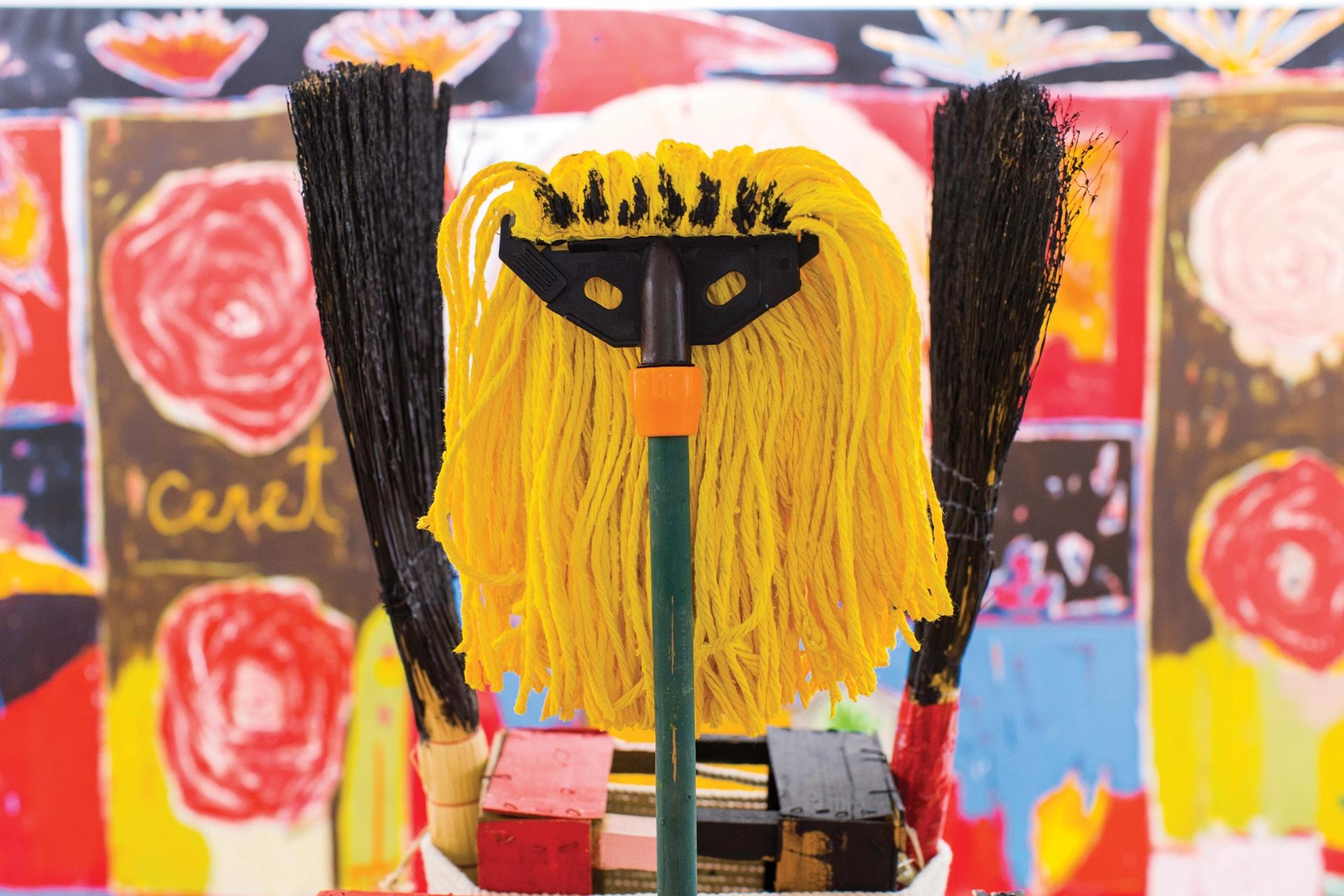
Installation view of Farshad Farzanki's Residents commission Rogue Visuals, 2018, Christopher Pike, all rights reserved
The Iranian-born artist Farshad Farzankia’s interest in the theme of migration seemed like a natural choice to explore further upon his arrival in Dubai. Almost cinematic in his approach to art, he has a natural inclination to attune to the rhythm of the places he inhabits and for him, Dubai is a place of constant flux where people are coming and going, just as the ocean ebbs and flows. For the residency, Farzankia has made three large-scale canvases and one large wood sculpture made from found objects that he gathered in Dubai. Conceptually, his practice also draws on his personal experience of relocating from his home city of Tehran to Copenhagen. He uses symbols of Iranian popular culture and his interest in visual narratives to build a symbolic lexicon influenced by the language of migration. Through his collage-style figurative and abstract compositions, he creates a jigsaw effect, piecing together the fragments of his own life as well as offering viewers an entry point into decoding their own experiences. Moving from working as a graphic designer into painting, Farzankia’s work poses questions about who is seen and why, and which objects hold meaning across borders.
Poonam Jain
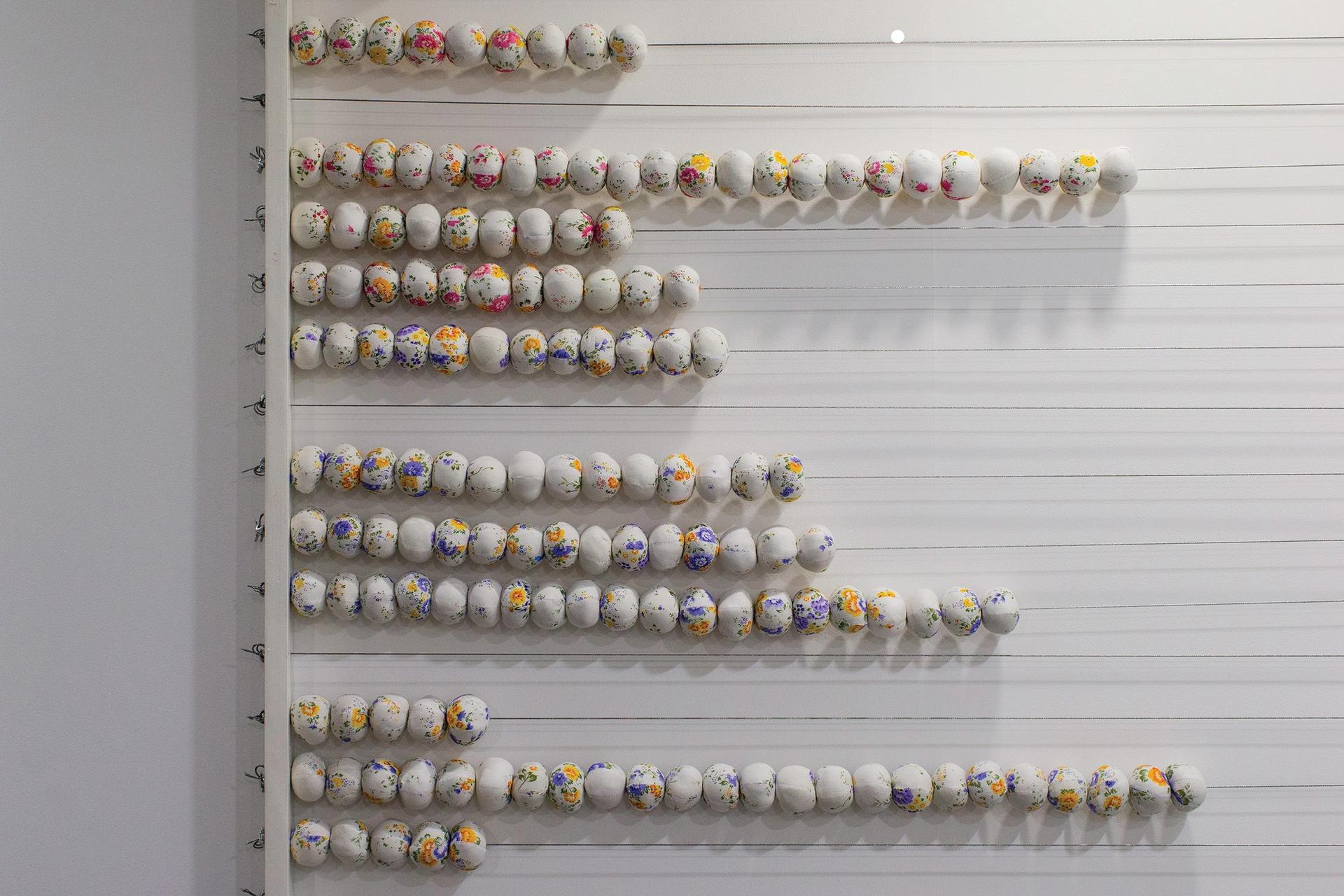
Installation view of Poonam Jain's Residents commission Rogue Visuals, 2018, Christopher Pike, all rights reserved
In her work, the Indian artist Poonam Jain focuses on architectural spaces and the numerical vocabulary that emerges from lived-in environments. She focuses on the act of counting— which can be a religious, political, domestic or economic endeavour— merging these notions to understand the narratives formed by the language of numbers. “Alphabets and numbers are the first lessons taught in school, which then becomes the lens through which the world is viewed,” she says.
In Dubai, Jain continues her investigations by looking at the Indian expatriates living in the city. She considers counting as encompassing several elements of life for these people, from personal finances (a literal kind of counting) to a sense of belonging (feeling counted within society) and a sense of freedom (looking at the physical and cultural boundaries that are put in place by life in the UAE). She also explores her own act of coming to Dubai as a resident artist, an employee of sorts, and compares her experience with the migrant workers that surround her. “Each work has its own story in a sense, but they bind together to talk about home in the context of economy and numbers,” she says.
Victor Ehikhamenor

Installation view of Victor Ehikhamenor's Residents commission Rogue Visuals, 2018, Christopher Pike, all rights reserved
Victor Ehikhamenor is a prolific artist, photographer and writer. Born in Nigeria, he has represented his native country at several international biennials, including the 2017 Venice Biennale. His abstract, symbolic and politically motivated works are inspired by traditional African religions and the interception of Western beliefs. History, memory and nostalgia converge in his vibrant painted pieces, which in recent years have been influenced by classic bronzes created by his ancestors in the old kingdom of Benin City. “I am thinking a lot about DNA and beginning to see the constellation of creativity, ideas and meaningfulness in what was created by classical African artists and what I am creating today,” he says. In Dubai, he has made a body of work that is in keeping with his signature brightly coloured and patterned work, but also in which the links between Africa and his immediate surroundings are clear. He wants to explore the modernity of the city as well as its ancient roots. “I believe there are similarities in our past stories, how we are influenced artistically, and I hope to seek that and wake it up from whatever slumber it may be in.”
Jennifer Ipekel
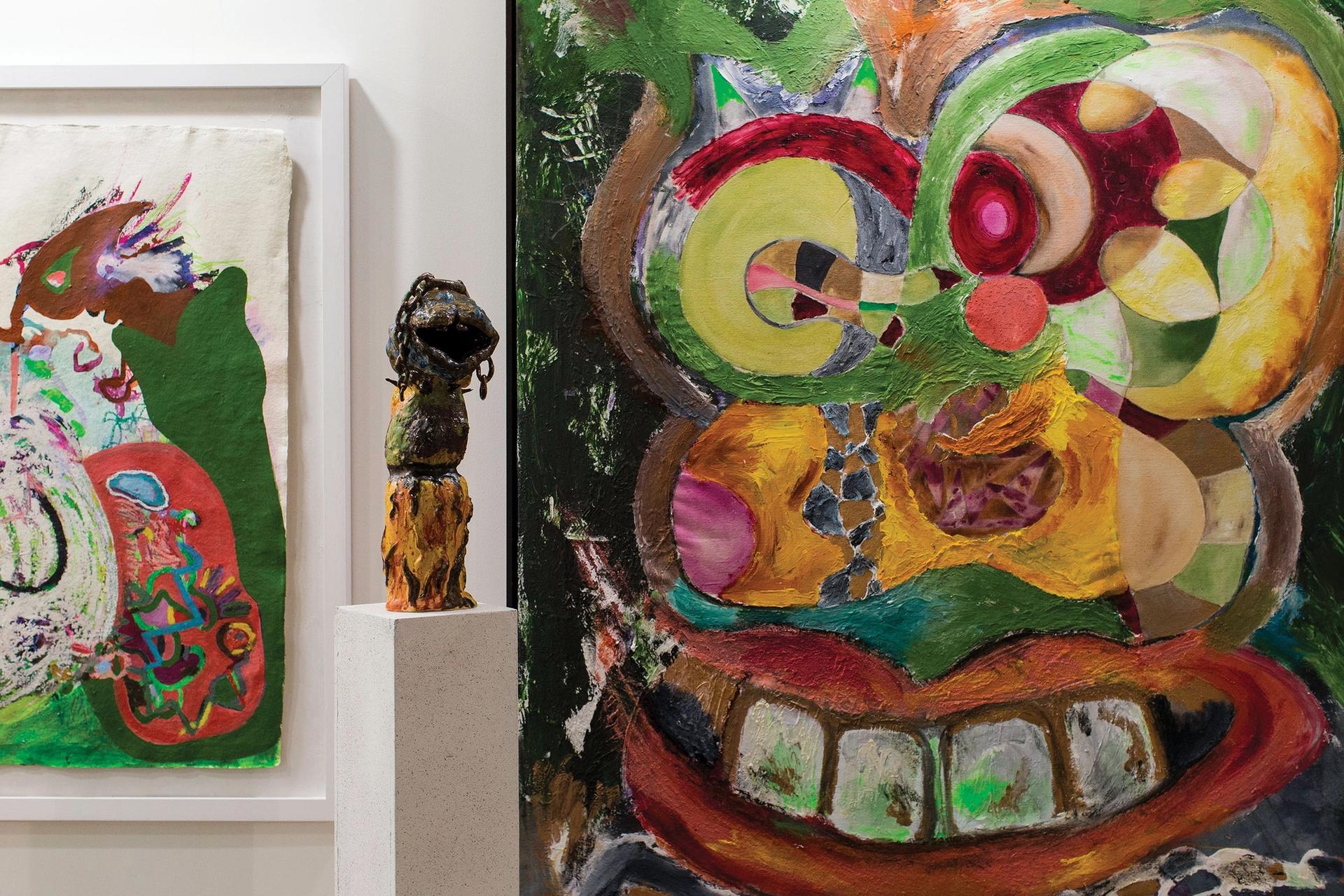
Installation view of Jennifer Ipekel's Residents commission Rogue Visuals, 2018, Christopher Pike, all rights reserved
In her paintings and sculptures, Jennifer Ipekel creates abstract narratives to build an individual mythology for the age that we live in, where she says fact and fiction are intertwined. Influenced by literature and music, her painting practice reimagines notions of power, gender and race as well as the idea of a hero figure. Dubai, for her, is a romantic location—a place where hyperbole and gritty reality collide; an ideal location to further her practice. She is also concerned with gender issues and for her residency, she has created a new series of canvases that depict rebellious heroes as female figures. “I chose this subject because I want to discuss not necessarily how women live here or how they behave, but how I believe they should be seen—as strong and powerful warriors,” she says. These figures are depicted only as loose forms, which are otherwise riotous blasts of colour that aim to access the subconscious mind. Threads of her practice are also underpinned by a fascination with forms found in the natural world, on which she led a workshop during her time in Dubai. Ultimately, Ipekel is interested in depicting the chaos of the current era by creating paintings of unknown territories that reflect the internal landscapes of the mind.
Zohra Opoku
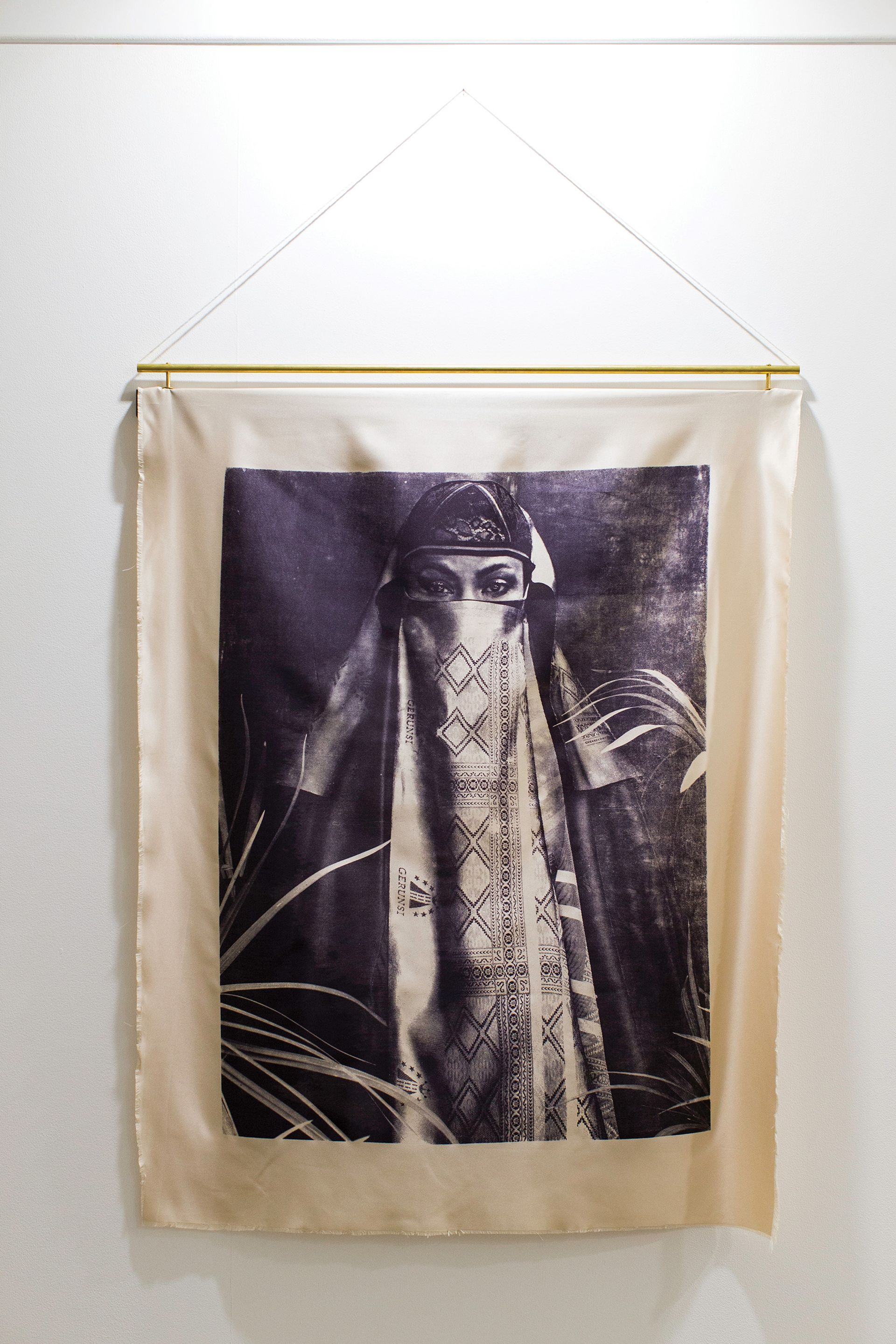
Zohra Opoku’s Sheltered (2017) Rogue Visuals, 2018, Christopher Pike, all rights reserved
Deeply attuned to the identity of otherness, Zohra Opoku’s practice is dedicated to investigating the politics of a hybrid identity. She is a German-Ghanaian artist who uses print and alternative photo processing methods, as well as textile and design techniques, to create works from various pieces of found material such as fabric and wood. During her time in Dubai, she has continued researching and working on her current series Harmattan Tales, which began in Ghana in October 2017. It investigates the layers of self as well as the prism of historical dialogues and the meaning of national identity. More specifically, she focuses on religious dress codes within Islam. “[The series] deals with the [in]visibility of the female body by focusing on the politics and aesthetics of Muslim dress codes, which is for me both stunning and disruptive,” she says. “The notion of being completely veiled in modern life, where practicality reigns, is an intriguing juxtaposition.” She is excited to be experimenting with urban symbolism and the colour codes of the UAE, such as the desert tones and the pure black of the hijabs.
Kristina Alisauskaite
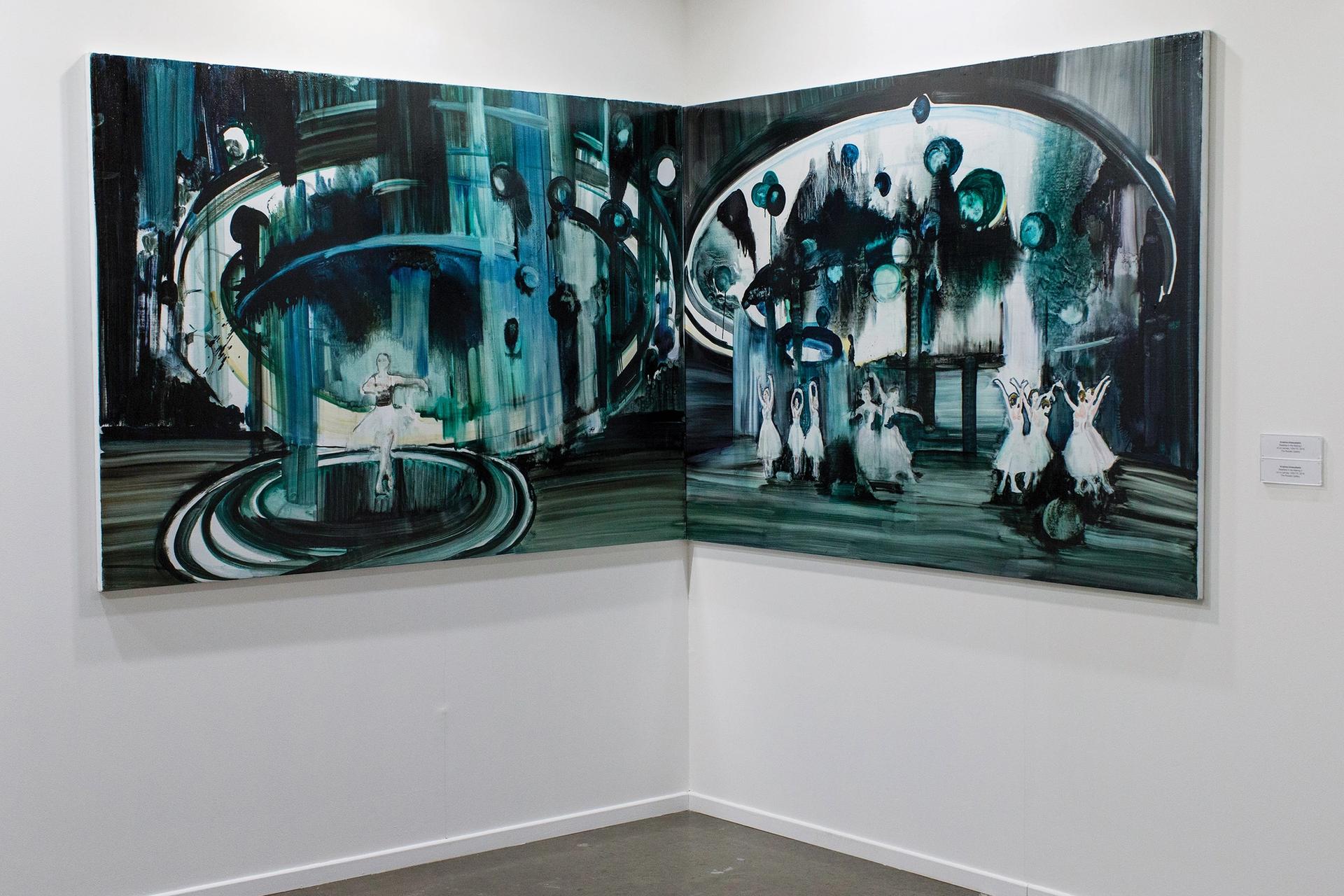
Kristina Alisauskaite's Realities in the making I and II (2017) Rogue Visuals, 2018, Christopher Pike, all rights reserved
The fragmentary and deeply gestural nature of Alisauskaite’s compositions depict the multilayered nature of reality. She describes her work as accessing deep-seated emotions that connect all of humanity. She is interested in the unseen, bringing to the fore what exists on the periphery and giving prominence to otherwise insignificant details. Part of a young generation of Lithuanian painters, she has visited Dubai before and has had work exhibited at Art Dubai, but she expects that the experience of living in the UAE will expand her perception and enrich her practice. For her residency, she has created a diptych filled with large spherical forms reminiscent of cosmic bodies, which reflect her interest in the metaphysical dimension as well as what she calls “the performance of life”. She is also showing a series of smaller portraits built up from details from her new surroundings. “The main theme of my artistic pursuits is to explore the less tangible experiences—feelings, moods, dreams and subconscious images—that exist beyond the material reality,” Alisauskaite says. “I am trying to draw attention to the nuances of human existence that we hardly notice.”


